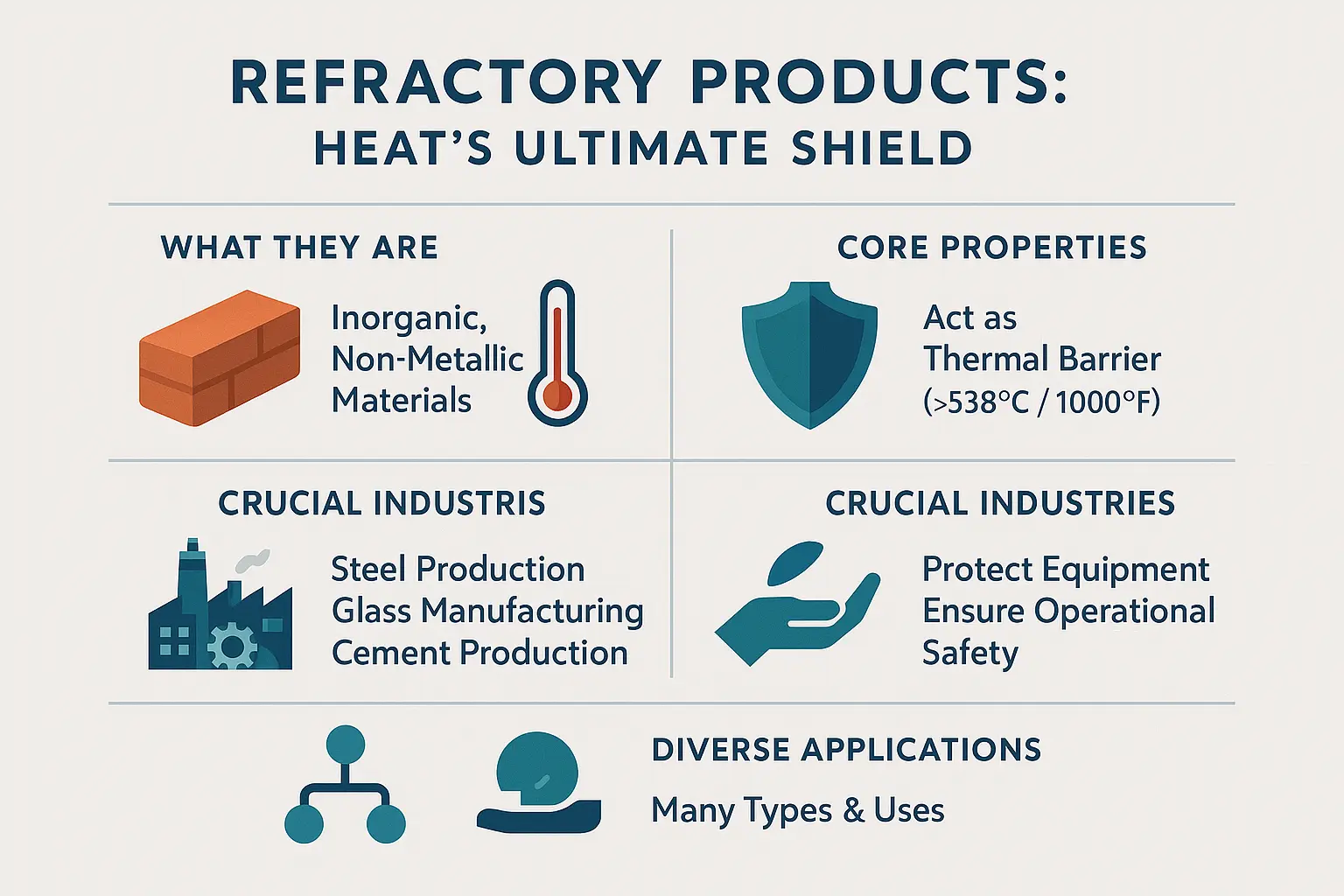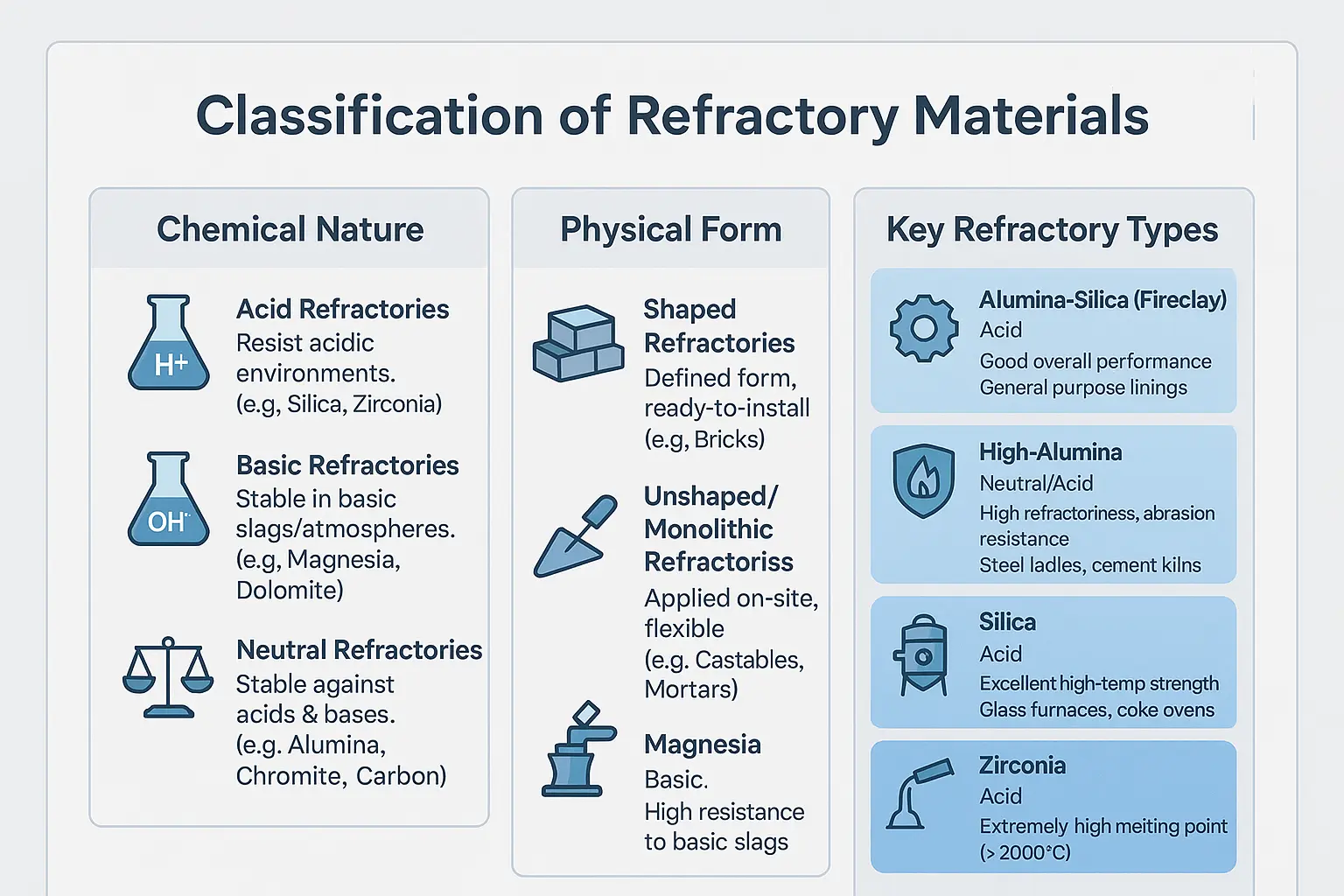When industrial processes push the boundaries of extreme heat, what stands between molten metals and catastrophic equipment failure? Refractory materials heat resistance—engineered to endure temperatures exceeding 538°C while maintaining structural integrity—act as the invisible armor protecting critical infrastructure. This article unveils how these unsung heroes combine thermal shock resistance, chemical stability, and customizable properties to shield industries like steelmaking, glass production, and aerospace. Discover why selecting the right refractory materials heat resistance isn’t just about survival—it’s about unlocking operational efficiency, safety, and innovation in environments where failure isn’t an option.
- What are refractory products: the first line of defense against heat
- Core properties that define heat resistance in refractory materials
- A classification of refractory materials
- Key refractory applications across industries
- Advanced considerations for optimal refractory performance
- Choosing the Right Refractory Shield for Your Application
What are refractory products: the first line of defense against heat
In industrial environments, refractory products serve as silent protectors. These inorganic, non-metallic materials endure extreme temperatures (often above 538°C / 1000°F) without decomposing, preserving structural integrity. Vital to steel, glass, and cement industries, they line furnaces, kilns, and reactors, ensuring safety. For example, they shield blast furnaces in steelmaking and prevent deformation in glass-melting tanks under intense heat.
Refractory materials heat resistance is their defining trait. They stay chemically and physically stable under thermal stress, resist shock from sudden temperature changes, and act as insulating barriers. Key properties—low thermal expansion, corrosion resistance, and controlled conductivity—protect equipment from molten metals, corrosive gases, and abrasion, preventing failures in high-risk settings. In cement kilns, their low thermal conductivity reduces energy loss, while abrasion resistance extends equipment lifespan.
Available in acidic to neutral compositions, these materials adapt to specific needs. Zirconia excels in ultra-high-heat zones, while alumina resists abrasion in cement kilns. Classifications—by temperature tolerance (normal, high, super refractories), conductivity (conductors vs. insulators), or chemical compatibility—showcase tailored applications. This guide will delve into their resilience, classifications, and role in sustaining industrial operations where heat threatens stability.

Core properties that define heat resistance in refractory materials
High temperature stability and melting point
Refractory materials must withstand extreme thermal exposure without deforming. Hafnium carbide (3890°C melting point) and tantalum hafnium carbide (4215°C) represent the pinnacle of heat resistance. These materials maintain dimensional stability at temperatures exceeding 2000°C, crucial for steelmaking furnaces and glass-melting tanks. Their crystalline structures—whether polycrystalline oxides like zirconia (ZrO₂) or non-oxide composites—prevent softening under operational loads, ensuring structural integrity in environments where molten metals and slags operate near their liquidus points.
Thermal shock resistance
Rapid temperature swings in industrial processes create thermal gradients that generate mechanical stress. Refractories with low thermal expansion coefficients (e.g., silicon carbide at 4.5×10⁻⁶/°C) and high thermal conductivity mitigate these stresses. For instance, zirconia-based materials exploit phase transformations to create microcracks that absorb energy, delaying catastrophic failure. This property is vital in steel ladles undergoing thermal cycling or rocket flame deflector coatings exposed to intermittent high-temperature exhaust. Thermal shock resistance directly determines service life in applications where sudden cooling (e.g., water quenching in metal processing) risks spalling and structural disintegration.
Thermal conductivity and insulation
Insulating refractories leverage porosity (13-20%) to reduce heat transfer. Calcium silicate bricks (≤1100°C service temp) and kaolin-based ceramics (≤1400°C) use interconnected pores to trap air, achieving thermal conductivities below 1.0 W/m·K. This minimizes energy losses in cement kilns and petrochemical reactors while maintaining compressive strength above 0.5 MPa. Insulating refractories also incorporate lightweight aggregates like vermiculite or alumina hollow spheres, balancing thermal performance with mechanical durability in non-load-bearing applications.
Chemical and physical stability
Refractories must resist chemical dissolution from slags containing corrosive components like FeO, which accelerates erosion by forming low-melting eutectics. Basic magnesia (MgO)-rich linings (≥85% MgO) neutralize basic slags in steel converters, while acid-resistant silica bricks (93% SiO₂) withstand glass-melting environments. Physical stability requires abrasion resistance against high-velocity molten metal streams in blast furnaces, with erosion rates below 0.5 mm/h in optimal designs. Porosity control (≤20% open pores) further prevents deep penetration of corrosive agents, preserving structural integrity over thousands of operational cycles.

A classification of refractory materials
Classification by chemical nature
Refractory materials protect industrial environments by combining heat resistance with chemical stability. Three primary chemical categories ensure operational reliability:
- Acid refractories: Resistant to acidic environments (e.g., silica with >92% SiO2 for glass furnaces, zirconia for glass melting). Silica’s cristobalite and tridymite phases enable thermal expansion control in coke ovens.
- Basic refractories: Stable in basic atmospheres (e.g., magnesia for steelmaking converters, chrome-magnesia for harsh conditions). Magnesia’s >2000°C melting point suits molten metal contact.
- Neutral refractories: Chemically inert to acids/bases (e.g., alumina for cement kilns, chromite for steel ladles). Graphite variants excel in reducing atmospheres, while chromite resists chemical attack.
Classification by physical form
Physical form determines application efficiency:
- Shaped refractories: Pre-formed bricks provide dimensional consistency for standard geometries like boiler linings.
- Unshaped refractories: Monolithic solutions like castables and plastic/ramming mixes enable seamless installations. Castables reduce installation time by 40% compared to bricks, with methods like gunniting and vibratory casting creating joint-free linings for complex shapes.
Main refractory types at a glance
| Refractory Type | Chemical Nature | Key Property | Common Application |
|---|---|---|---|
| Alumina-Silica (Fireclay) | Acid | Cost-effective with broad thermal stability (1580–1780°C) | General furnace linings, boiler linings |
| High-Alumina | Neutral/Acid | Exceptional abrasion resistance at >1600°C | Steel ladles, cement kilns |
| Silica | Acid | Strength retention at 1700°C with low thermal expansion | Glass furnaces, coke ovens |
| Magnesia | Basic | Corrosion resistance against basic slags in steelmaking | Steelmaking converters, non-ferrous furnaces |
| Zirconia | Acid | Unmatched >2000°C melting point with low wettability | Continuous casting nozzles, glass melting channels |
This classification system highlights how material properties align with industrial challenges. Zirconia’s >2000°C stability prevents nozzle erosion in steel casting, while silica’s phase transformations control thermal expansion in glass furnaces. The shaped/unshaped distinction balances installation speed with structural integrity—castables eliminate joint-related failure points, reducing maintenance costs by 30%. In critical sectors like steelmaking and cement production, selecting the right refractory chemistry and form prevents catastrophic failures that could halt operations and compromise safety.
Key refractory applications across industries
The backbone of metal and steel production
Refractory materials are critical in metal and steel production, where they account for approximately 70% of industrial usage. In blast furnaces, ladles, and basic oxygen furnaces (BOF), these materials contain molten metal and corrosive slags at temperatures exceeding 1,500°C. Basic refractories like magnesia (MgO) dominate due to their resistance to alkaline slags and high-temperature stability. For instance, magnesia-carbon bricks are standard in electric arc furnaces (EAF), preventing erosion while maintaining structural integrity under thermal stress.
Essential for glass and cement manufacturing
In glass manufacturing, refractories endure constant exposure to molten glass (up to 1,600°C) and chemical corrosion. Silica and zirconia-based materials, such as electrofused AZS bricks, resist erosion from glass melt rich in SiO₂ and alkali oxides. In cement production, rotary kilns operate at 1,450°C, where alumina-silica refractories combat abrasive clinker and chemically aggressive phases like C3S. These materials ensure kiln longevity despite cyclic thermal stress and alkali attacks from alternative fuels.
Protecting other high-temperature processes
Refractories extend beyond metallurgy to environments demanding thermal resilience:
- Incinerators: Lining combustion chambers against corrosive flue gases and abrasive ash.
- Petrochemical industry: Shielding reformers, fluid catalytic crackers (FCCU), and hydrogen reformers from carbon penetration and thermal shocks.
- Aerospace: Flame deflectors in rocket launchpads, withstanding temperatures above 3,000°F during propulsion.
- Foundries: Crucibles and molds for metal casting, utilizing graphite’s thermal conductivity in non-oxidizing atmospheres.
By tailoring material composition—acidic (silica), basic (magnesia), or neutral (alumina)—refractories address unique challenges across sectors, ensuring operational safety and minimizing downtime.
Advanced considerations for optimal refractory performance
Did you know a single flaw in refractory material selection could lead to catastrophic industrial failures? Let’s uncover the hidden science behind high-performance refractory solutions.
Measuring performance under real-world conditions
Refractory materials aren’t tested in isolation—they face the brutal reality of industrial environments. The Refractoriness Under Load (RUL) test reveals the temperature at which materials deform under 300 kPa of pressure, simulating real operational stress. Think of it as stress-testing your furnace’s armor.
Why trust melting points? RUL gives a practical threshold for material failure. Even better, the Pyrometric Cone Equivalent (PCE) test uses Seger cones to show softening points. These metrics aren’t just numbers—they’re survival guides for your equipment.
The impact of microstructure on performance
Porosity isn’t just a technical detail—it’s a critical design choice. Imagine a tightrope walker balancing insulation and strength. High-porosity materials excel at thermal isolation but falter under mechanical stress. Low-porosity (high-density) bricks stand firm but conduct heat like a highway. Which side of the tightrope do you want to be on?
Microstructure controls everything: grain size, pore distribution, and phase composition. The wrong balance risks thermal shock, chemical attack, or premature failure. This knowledge gap could cost industries millions in downtime annually.
Enhancing durability with refractory coatings
Here’s a secret: coatings can double the lifespan of refractory systems. Refractory coatings aren’t surface treatments—they’re game-changers. Nanomaterials create molecular armor against abrasion. Advanced CVD and PVD techniques deposit protective layers atom-by-atom, sealing pores and resisting corrosion.
Why gamble with replacement costs when coatings extend equipment life? From plasma spraying to cold dynamic spraying, these innovations reduce maintenance urgency and increase operational confidence. The future belongs to those who embrace these protective technologies today.
Choosing the Right Refractory Shield for Your Application
Refractory materials are the unsung heroes in extreme industrial environments, acting as critical barriers against temperatures exceeding 538°C while maintaining structural resilience. Selecting the ideal solution isn’t just about heat resistance—it requires balancing chemical stability, mechanical durability, and thermal efficiency to ensure operational safety and cost-effectiveness.
- Increased equipment lifespan: By protecting structural components from heat and corrosion.
- Improved energy efficiency: Through effective thermal insulation, reducing heat loss by up to 25% in high-temperature systems.
- Enhanced process safety and stability: By ensuring containment integrity in steel, glass, and cement production.
- Optimized operational costs: Minimizing downtime by up to 50% in critical installations.
Industrial leaders face a pivotal decision: generic solutions often lead to premature failures, while tailored systems—like those engineered by MXS Refractories—deliver precision. Our expertise spans high-performance refractory design, material sourcing, and on-site supervision for industries such as steel, glass, and cement. With decades of refining custom solutions, we address variables like localized wear zones, thermal cycling, and chemical exposure to extend lining life by 2-3x versus standard materials. By partnering with MXS, you gain access to advanced insulation technologies that cut energy consumption by 15-30% while maintaining structural integrity under extreme thermal stress.
Selecting the right refractory material is critical for ensuring operational efficiency, safety, and cost-effectiveness in high-temperature environments. By balancing heat resistance, chemical stability, and mechanical demands, industries can achieve enhanced equipment longevity, energy savings, and process reliability. At MXS Refractories, we provide tailored solutions to meet these complex challenges, ensuring optimal performance across diverse industrial applications.
